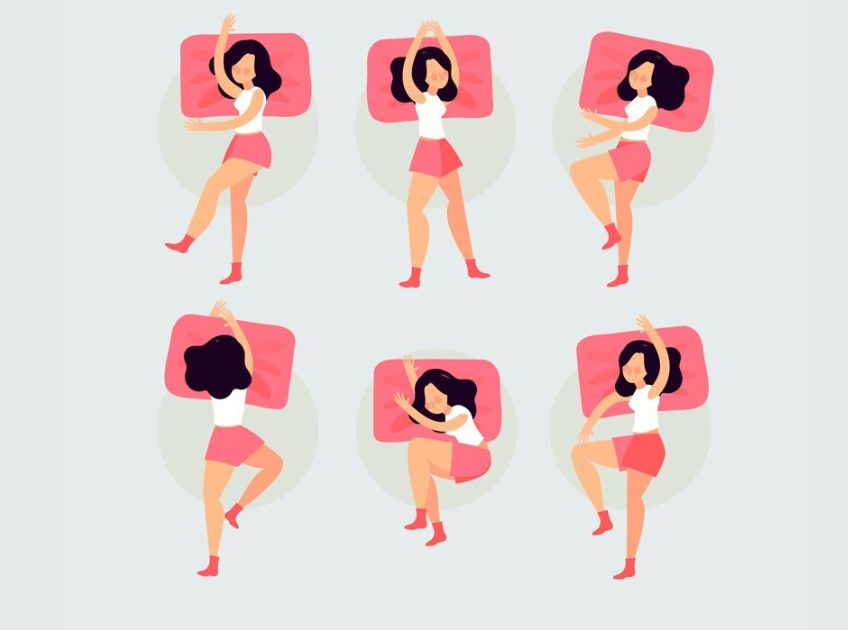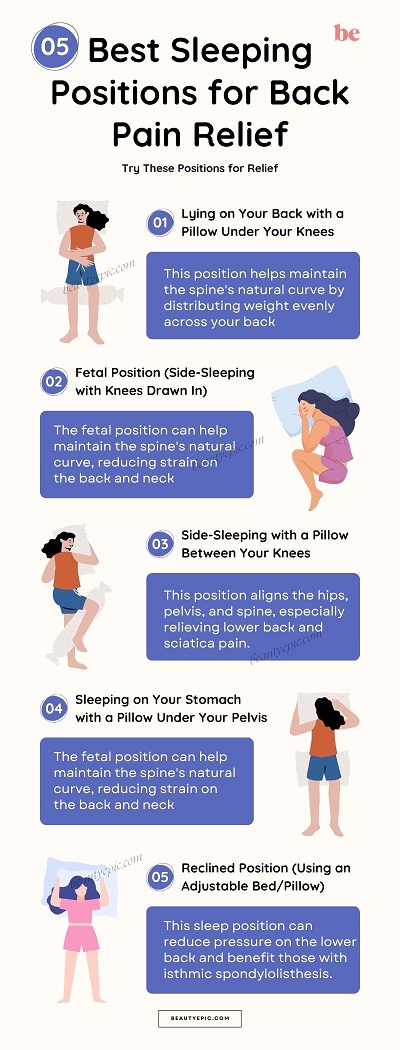
Important: This article is for informational purposes only. Please read our full disclaimer for more details.
Back pain can make it nearly impossible to get a good night’s sleep. Whether it stems from poor posture, injury, or a chronic condition, how you sleep can significantly impact your spinal alignment and pain levels. The right sleeping position can promote healing, reduce strain, and help you wake up feeling refreshed.
In this guide, we explore the top 5 sleeping positions proven to relieve back pain, based on expert advice and scientific evidence.
The Best Sleep Positions for Back Pain Relief
Let’s break down the top five sleeping postures that help alleviate discomfort and support spinal health.
1. Lying on Your Back with a Pillow Under Your Knees
- Why it works: This position helps maintain the spine’s natural curve by distributing weight evenly across your back.
- How to do it: Lie flat and place a small pillow or rolled towel under your knees to take pressure off your lower back.
- Evidence: A study in Sleep Health (2017) confirmed that back sleeping with knee elevation improves spinal posture and reduces nighttime discomfort (1)(2).
2. Fetal Position (Side-Sleeping with Knees Drawn In)
- Why it works: Curling up opens space between vertebrae and reduces pressure on the discs, especially helpful for herniated discs.
- How to do it: Lie on your side, tuck your knees toward your chest, and use a supportive pillow for your head.
- Tip: Switch sides occasionally to prevent muscular imbalance.
3. Side-Sleeping with a Pillow Between Your Knees
- Why it works: This position aligns the hips, pelvis, and spine, especially relieving lower back and sciatica pain.
- How to do it: Sleep on one side with a firm pillow placed between your knees to keep your spine straight.
- Study Support: Research published in The Journal of Physical Therapy Science (2015) found that this posture reduces spinal rotation and stress on the lumbar area (3).
4. Sleeping on Your Stomach with a Pillow Under Your Pelvis
- Why it works: While stomach-sleeping is generally discouraged, placing a pillow under the pelvis can reduce strain on the spine for some.
- How to do it: Use a thin pillow under your stomach or hips and avoid using a head pillow to reduce neck strain.
- Best For: People with degenerative disc disease or disc space narrowing.
Reclined Position (Using an Adjustable Bed or Wedge Pillow)
- Why it works: A reclined sleeping posture can reduce pressure on the lower back and benefit those with isthmic spondylolisthesis.
- How to do it: Use a wedge pillow or adjustable bed to sleep in a partially upright, reclined position.
- Clinical Insight: According to Spine Journal (2016), sleeping at a 30–45 degree angle helps minimize lumbar disc pressure (4).
Backed by Science: How Sleeping Positions Affect Pain
Scientific literature supports the direct relationship between sleep posture and spinal health. Studies show that poor sleep posture contributes to mechanical stress on the spine, exacerbating both acute and chronic back pain.
- A 2019 study published in BMJ Open linked poor sleep posture with increased morning pain and stiffness in adults with lower back issues (5).
- The use of ergonomic pillows and supportive mattresses was found to improve sleep quality and reduce musculoskeletal pain in trials referenced in The Lancet Rheumatology (6).
Understanding the biomechanics of how you sleep can lead to lasting relief without medication.
Frequently Asked Questions (FAQ’S)
1. What is the worst sleeping position for back pain?
A. Sleeping on your stomach without any support under the pelvis is generally the worst for back pain, as it flattens the spine’s natural curve and strains the neck.
2. Can a mattress make a difference in back pain?
A. Yes. A medium-firm mattress is often recommended for back pain as it supports natural spine alignment without excessive sinking or rigidity.
3. How long does it take for sleep position changes to help back pain?
A. Some people notice improvement within a few nights, while others may take a few weeks. Consistency and proper pillow/mattress support play a key role.
Final Thoughts
Your sleep position is more powerful than you might think. Choosing the right posture can be a natural, medication-free way to manage or reduce back pain. Pairing an ergonomic sleep position with a supportive mattress and the right pillow can greatly improve spinal alignment and your overall quality of life.
If your back pain persists or worsens despite adjustments, consult a healthcare provider to rule out underlying conditions.
















